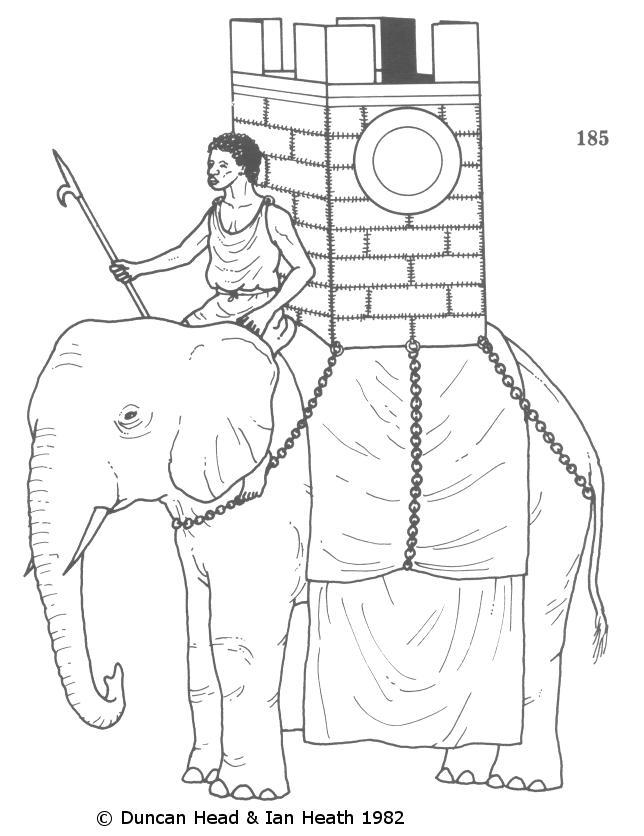
Try Amazon Audible Premium Plus and Get Up to Two Free Audiobooks
AFRICAN ELEPHANT
An extract from Armies of the Macedonian and Punic Warsby Duncan Head, illustrated by Ian Heath

185. AFRICAN ELEPHANT


Unlike the previous illustrations, all of the Indian species of elephant, this is of the small African "forest" species, Loxodonra Africana cycloris. This, or perhaps a now extinct race of similar size, was hunted in modern Eritrea and Somalia and in Numidia, and used in war first by the Ptolemies, then by Carthage and the Numidians. A Ptolemaic inscription differentiates between Ethiopian and Trogodytic elephants, but the distinction may refer only to the area where they were hunted, not to any difference of race. The African forest elephant is 7-8 feet (2.1 5-2.45m) tall at the shoulder, shorter than the Indian elephant at up to 10 feet (3.lm), and much smaller than the great African bush elephant, not used in war, which can be up to 13 feet (4m). It was an ancient commonplace that African elephants were smaller and weaker than Indians, and could not stand up to them in battle. Differences between the species include the African’s more strongly segmented or ridged trunk, ending in two "fingers" rather than one, and the line of its back is concave or flat, while the Indian’s is convex. The small forest elephant also has rounded ears and small, straight tusks.
Although smaller, the African elephant was strong enough to bear the weight of towers, crew and armour. Ptolemaic beasts at Raphia carried sarissa-armed men in towers, while king Juba’s Numidian elephants were both turreted and armoured. H. H. Scullard has suggested that Carthaginian elephants did not use towers, as there are no reliable textual references to them, while the Ptolemies at Raphia needed crewmen specifically to protect the elephant and driver from Seleucid elephant crewmen, but the Carthaginians had no such special need. But against this, several works of art do show Hannibal’s elephants towered, including the statuette on which this figure is based; while the Numidians, who similarly had no specific pressing need for towers or crewmen, did use them, and must have learned their elephant techniques from Carthage. They are likely to have been following Carthaginian practice in giving their elephants towers, just as the Carthaginians learned to use elephants from Pyrrhos’ turreted examples. Some later written sources also mention Carthaginian towers, though this may be mere literary commonplace. True, occasional coins show Punic elephants with driver only, but these elephants are not shown in battle, and are perhaps on the march. On balance, the plentiful positive artistic evidence seems to outweigh the lack of reliable literary confirmation, and it seems to me highly probable that Carthaginian elephants did in fact use towers, perhaps containing two javelinmen, as Pyrrhos’ had done.
The figure shows a Negro mahout in Numidian-style tunic. Hasdrubal’s mahouts at the Metaurus carried a mallet and chisel, with which they could kill the elephant, by swift blow to the base of the skull, if it went amok and attacked its own men. This was a relatively recent innovation, introduced by Hasdrubal himself to counter one of the chief dangers of using elephants. The tower may be of hides stitched over a wooden framework, and is held on by chains. The central one seems to pass through the lower saddlecloth. One carved gem shows an open railed platform on which two javelinmen stand, perhaps a lighter alternative to the tower.